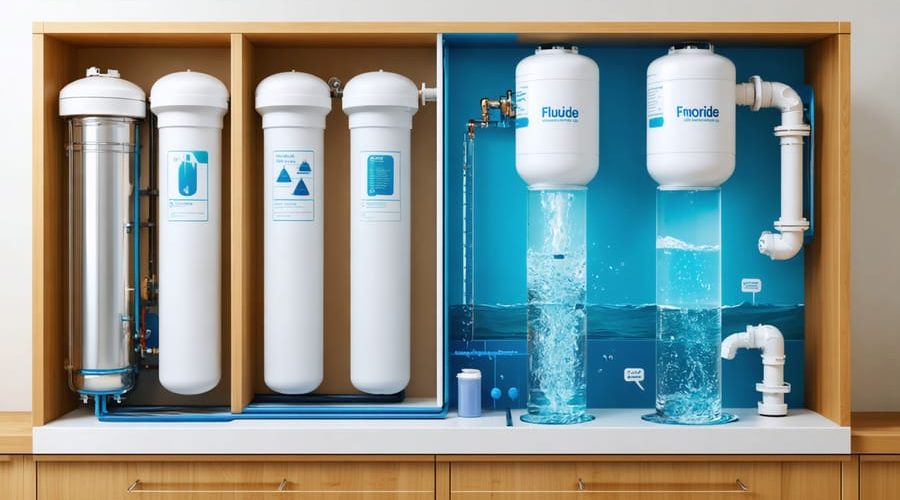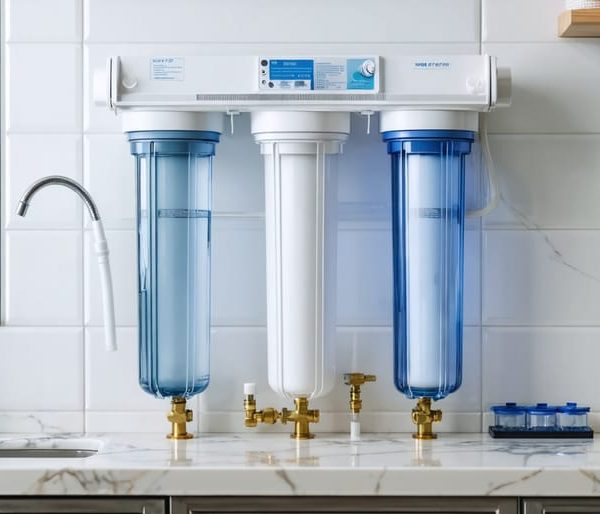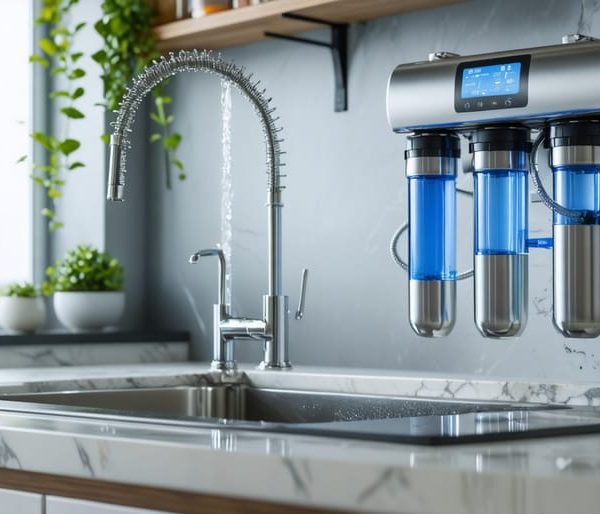Removing fluoride from your home’s water supply requires specialized filtration systems that go beyond standard carbon filters. While municipal water fluoridation remains a common practice across America, affecting nearly 200 million people, homeowners can effectively eliminate fluoride using specific technologies. Reverse osmosis systems, activated alumina filters, and bone char filtration stand out as the most reliable methods, consistently removing up to 95% of fluoride from drinking water.
Understanding your options is crucial because many popular water filters, including basic carbon pitchers and faucet-mounted units, don’t effectively tackle fluoride. Recent advances in home filtration technology have made professional-grade fluoride removal both accessible and affordable for households concerned about their water quality. Whether you’re sensitive to fluoride or simply prefer more control over your water’s chemical composition, installing the right filtration system represents a significant step toward cleaner, more customized drinking water.
This guide explores the most effective fluoride filtration methods, helping you make an informed decision about protecting your household from unwanted fluoride exposure while maintaining essential mineral content in your drinking water.
Which Home Filtration Systems Actually Remove Fluoride?
Reverse Osmosis Systems
Reverse Osmosis (RO) systems stand out as one of the most effective solutions for fluoride removal, capable of filtering out up to 95% of fluoride from your drinking water. Understanding how RO systems remove fluoride helps explain their exceptional performance: water is forced through a semi-permeable membrane with microscopic pores that block fluoride ions while allowing pure water molecules to pass through.
The process involves multiple filtration stages, typically including sediment filters, carbon filters, and the crucial RO membrane. This comprehensive approach not only targets fluoride but also removes other contaminants like chlorine, lead, and dissolved solids. The RO membrane’s pore size, typically around 0.0001 microns, is small enough to catch fluoride ions, which are relatively large compared to water molecules.
What makes RO systems particularly reliable is their consistent performance over time. While the initial investment might be higher than other filtration methods, the long-term benefits include superior filtration quality and reduced maintenance needs. Most systems include a monitoring system that indicates when it’s time to replace filters or membranes, ensuring optimal fluoride removal throughout the system’s lifetime.
To maintain peak performance, regular maintenance is essential. This includes replacing pre-filters every 6-12 months and the RO membrane every 2-3 years, depending on your water quality and usage patterns. While these systems do produce some wastewater during the filtration process, newer models are increasingly water-efficient, making them a more sustainable choice for environmentally conscious homeowners.
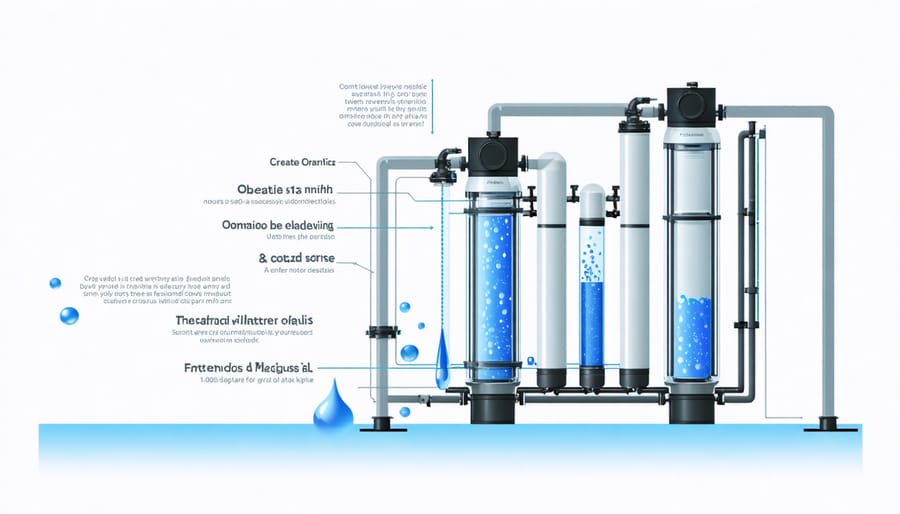
Activated Alumina Filters
Activated alumina is one of the most effective methods for removing fluoride from drinking water, with removal rates reaching up to 98% under optimal conditions. This specialized filtration material consists of aluminum oxide that’s been processed to create a highly porous surface with tremendous absorptive properties.
The process works through adsorption, where fluoride ions are attracted to and bind with the activated alumina surface. This material is particularly selective for fluoride, making it more effective than many other filtration methods. However, its effectiveness depends on several factors, including water pH, flow rate, and the initial fluoride concentration.
For optimal performance, activated alumina filters work best with slightly acidic water (pH 5.5-6.5) and slower flow rates that allow sufficient contact time between the water and filter media. These filters typically need replacement every 6-12 months, depending on usage and local water conditions.
While activated alumina is highly effective, it does have some limitations. The filtration efficiency can decrease when water contains high levels of competing ions like arsenic or sulfate. Additionally, the filter’s performance may decline in alkaline conditions, and very hard water can reduce its effectiveness.
For homeowners considering this option, it’s important to note that activated alumina filters require proper maintenance and regular monitoring to ensure optimal fluoride removal. Professional installation is often recommended to ensure the system is correctly configured for your specific water conditions.
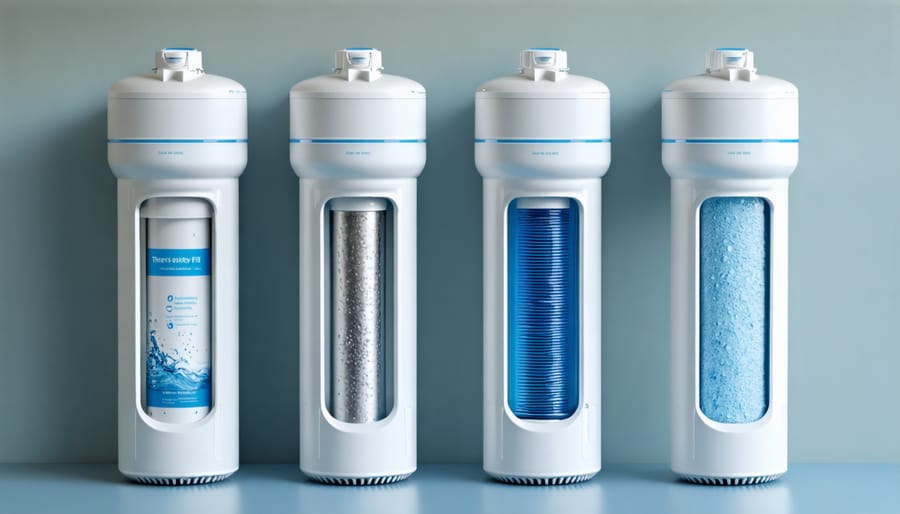
Common Filters That Don’t Remove Fluoride
Standard Carbon Filters
While standard carbon filters are excellent at removing many common water contaminants like chlorine, volatile organic compounds (VOCs), and unpleasant tastes and odors, they’re ineffective at removing fluoride from your drinking water. This limitation exists because of the unique chemical properties of fluoride ions and how they interact with activated carbon.
The activated carbon in these filters works through a process called adsorption, where contaminants stick to the surface of the carbon particles. However, fluoride ions are too small and chemically stable to be captured by this mechanism. They simply pass through the carbon filter along with the water molecules, leaving fluoride levels essentially unchanged.
This is why many homeowners are surprised to discover their carbon-based pitcher filters or faucet-mounted systems aren’t reducing fluoride levels, despite effectively cleaning their water in other ways. For successful fluoride removal, you’ll need to consider alternative filtration methods specifically designed to target fluoride ions, such as reverse osmosis systems or activated alumina filters.
Basic Pitcher Filters
Standard water filter pitchers, while popular and convenient, typically fall short when it comes to fluoride removal. These basic filtration systems usually rely on activated carbon filters, which are excellent for improving taste and removing chlorine but aren’t designed to tackle fluoride. The activated carbon process simply doesn’t have the right molecular structure to effectively capture fluoride ions from your drinking water.
Most pitcher filters use a combination of carbon and ion exchange resins, primarily targeting common contaminants like chlorine, lead, and copper. However, fluoride molecules are too small and chemically stable to be trapped by these conventional filtering mechanisms. Testing has shown that basic pitcher filters generally remove less than 5% of fluoride content, making them an ineffective choice for households specifically concerned about fluoride consumption.
For those seeking genuine fluoride reduction, it’s important to look beyond standard pitcher solutions and consider more specialized filtration methods designed specifically for fluoride removal.
Installation and Maintenance Considerations
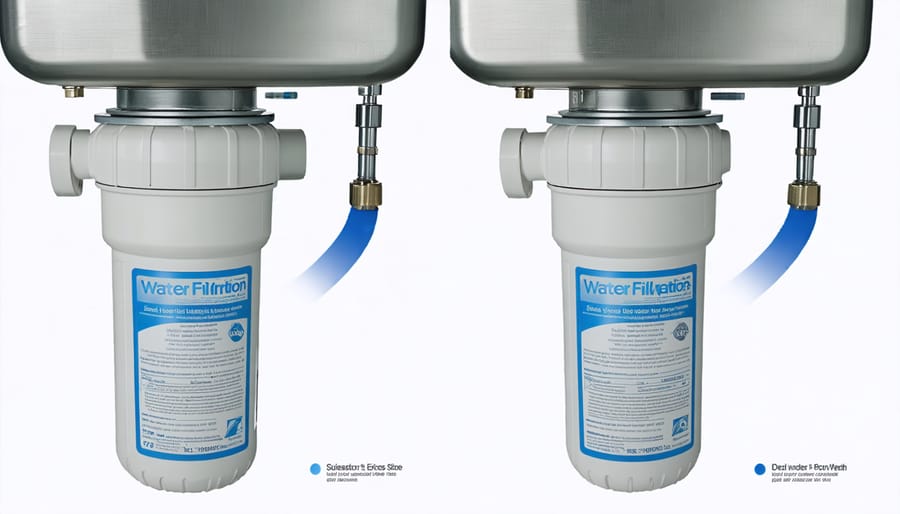
Cost Factors
When considering fluoride removal systems, budget planning should account for both initial investment and long-term maintenance costs. Entry-level countertop filters typically range from $50-150, while more comprehensive installing under-sink filtration systems can cost between $200-500. Whole-house systems represent the highest initial investment, usually starting at $800 and potentially reaching $2,500 for premium installations.
Ongoing expenses include regular filter replacements, which vary by system type and water usage. Expect to spend $60-120 annually for countertop filters, $100-200 for under-sink systems, and $200-400 for whole-house filter maintenance. Some systems may require professional servicing, adding $50-150 per visit to your maintenance budget.
Additional factors affecting total cost include water quality testing ($30-100), potential plumbing modifications, and increased water pressure monitoring. While the initial investment might seem substantial, consider the long-term savings compared to purchasing bottled water, which can exceed $600 annually for a typical family.
Maintenance Requirements
Regular maintenance is crucial for ensuring your fluoride filtration system continues to work effectively. Following a proper filter replacement schedule is essential, as most fluoride-removing cartridges need replacement every 6-12 months, depending on your water usage and initial fluoride levels.
For reverse osmosis systems, clean the membrane every 3-4 months to prevent scaling and bacterial growth. Check and replace pre-filters regularly, typically every 3-6 months, to protect the main fluoride-removing components. Bone char and activated alumina filters require periodic backwashing to maintain optimal performance.
Monitor your system’s performance by testing fluoride levels quarterly using a reliable water testing kit. Keep track of water pressure and flow rate – a significant decrease might indicate it’s time for maintenance. Clean filter housings and check O-rings during cartridge changes to prevent leaks.
For activated alumina systems, regenerate the media according to manufacturer specifications, usually every 3-6 months, to maintain removal efficiency. Document all maintenance activities to establish a consistent care routine that ensures continuous fluoride removal.
Choosing the right water filtration system for fluoride removal is a crucial decision that impacts your family’s health and well-being. As we’ve explored throughout this article, not all filtration systems are equally effective at removing fluoride from your drinking water. Reverse osmosis systems and activated alumina filters stand out as the most reliable options, while popular alternatives like activated carbon filters often fall short in fluoride removal.
When selecting a filtration system, consider your household’s specific needs, including water consumption, available space, and budget. Remember that initial costs should be weighed against long-term benefits and maintenance requirements. Regular filter replacement and system maintenance are essential for optimal performance and longevity.
For those ready to take action, start by testing your water to determine current fluoride levels. This baseline information will help you choose the most appropriate system and verify its effectiveness once installed. Consider consulting with a water quality professional to ensure proper installation and maintenance procedures.
By investing in an effective fluoride filtration system, you’re taking a significant step toward cleaner, healthier water for your household. Whether you choose reverse osmosis or activated alumina, remember that the best system is one that meets your specific needs while providing reliable fluoride removal. Stay informed about your water quality and maintain your chosen system regularly to ensure continued protection for you and your family.
